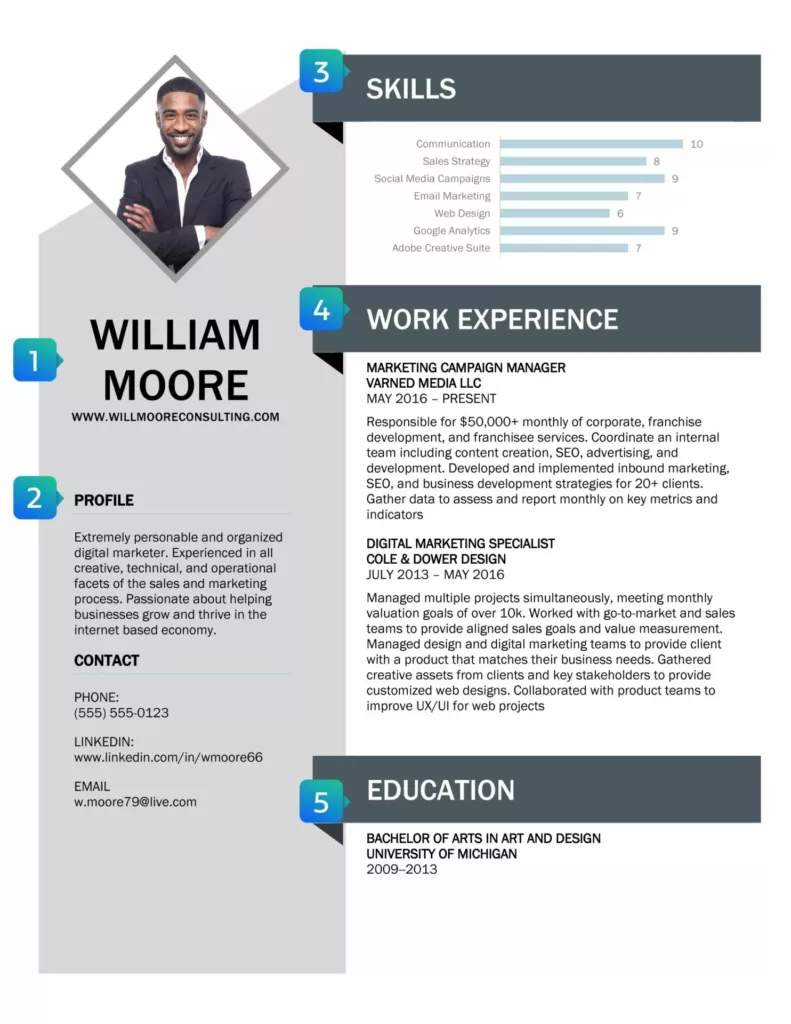What is a creative resume?
The creative resume style is one that doesn’t adhere to traditional norms in terms of format and content. It’s eye-catching and visually appealing, making use of unique elements like color, font formatting, and graphics to convey information.
Candidates using a creative format often provide outside links to multimedia content like videos and online portfolios, which are important for design-based and other creative roles. You might include a headshot even, as seen in the example creative resume shown below.
A creative resume can help you stand out when applying for jobs that value outside-the-box thinking. It can also help you showcase skills that are relevant to the job, like graphic design or data visualization.
Who should use a creative resume?
- Anyone applying for jobs in creative fields like design, media, film, or tech
- Job seekers looking to use their resume to showcase relevant skills
- Applicants to jobs that require a portfolio or other supporting materials
- Candidates with an especially lengthy or diverse work history who want to sharpen the focus on their skills
Who shouldn’t use this type of resume?
- Candidates for jobs in conventional fields like law or banking
- Applicants to jobs that use an applicant tracking system (ATS), which can’t read most creative resumes
- People who are more comfortable working with text-based formatting
Creative resume format and key components
Assuming you’re in a field that accepts it, building your resume can actually be a lot of fun. The format you use and the components you include are entirely up to you based on what you wish to showcase. If you’re applying for a video production job, for example, you might create a video clip to accompany each section of your resume.
Even though you should think outside the box, there are still a few essential components to include that most hiring managers will be looking for:
- Contact info and website link
For most creative professionals, your skills can’t be summed up in words on paper. That’s why it’s essential to include a website with additional assets that demonstrate your abilities in addition to your regular contact info. This might be a personal blog that showcases clips if you’re a writer or a portfolio of your images if you’re a photographer. Include links that give hiring managers the opportunity to explore your skills beyond your resume. - Profile
A profile is a short statement that sells your strengths and sums up your most relevant experience. Unlike in a traditional resume, where it’s best to keep your summary focused on professional skills, the profile in a creative resume might include tidbits that help the hiring manager learn more about the candidate as a person, like passions and hobbies.
- Skills
Even if you’re using this format, you still need to focus on highlighting the skills that are most important for the job. Use the job description to discern which skills the hiring manager is most likely to be looking for, then tailor your resume for each application. Visuals like graphics can be a great tool for showcasing different skills–see the resume shown here for an example. - Experience
No matter how eye-catching your resume is, most hiring managers will still go straight to your work experience section first. Be sure to include the essentials–the name of the company, your position, and the dates you were employed–along with your most noteworthy achievements. - Education
List the name of the institution and the degree or credential you received. If you’ve received any specialized training that’s related to the job, it can be included here, too.
Need help crafting a resume?
Build the perfect creative resume today to land your dream job!
